



















|
 |
|
 |

Makedonia is among the Diadochoi, and thus still fights in the Macedonian manner. Of course, why use other tactics when those employed by Philippos & Alexandros made Makedonia into the biggest empire that has ever existed, though for a short while. The Makedonians continue to fight in the same manner as before, which means a heavy focus on pike phalanxes & heavy cavalry, although good quality flanking infantry, lighter cavalry & assault infantry are also available.
Hoplitai Haploi (Greek Levy Hoplites)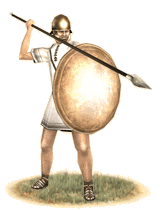 The poorest citizens of the Hellenic and Makedonian poleis fought as a militia roughly organized along the lines of other, more professional hoplite soldiers. They are organized in the phalanx and are quite high quality for militia, due to the dogged Hellenic spirit and fighting tradition. They can be expected to hold a line against most light and medium infantry, though they will be devastated by missile troops, as they have virtually no protection from missiles aside from their shields and the bodies of their compatriots. They are still useful against cavalry as no horse will willingly charge a bristling wall of spear points. Hoplitai Haploi, if used properly, can be an inexpensive and very valuable unit, though they will be outclassed against heavier and more professional troops, they can, if well supported, hold the line far better than one would expect of a militia. The poorest citizens of the Hellenic and Makedonian poleis fought as a militia roughly organized along the lines of other, more professional hoplite soldiers. They are organized in the phalanx and are quite high quality for militia, due to the dogged Hellenic spirit and fighting tradition. They can be expected to hold a line against most light and medium infantry, though they will be devastated by missile troops, as they have virtually no protection from missiles aside from their shields and the bodies of their compatriots. They are still useful against cavalry as no horse will willingly charge a bristling wall of spear points. Hoplitai Haploi, if used properly, can be an inexpensive and very valuable unit, though they will be outclassed against heavier and more professional troops, they can, if well supported, hold the line far better than one would expect of a militia.
Historically, the poorest citizens of any polis and the peasants on the estates of Makedonia were called up in defense of their homeland to fight as militia. They had been used to devastating effect in many ancient battles while forming the second line of battle. They were good and courageous soldiers that fought with a degree of discipline and courage that would not be thought possible of an unprofessional milita. They were not cowards and did not break quickly, but were often annihilated if facing good missile troops or heavier, more professional infantry. Peltastai and other units armed with javelins were particularly devastating to the militia hoplites, due to their lack of protection on the battlefield.
Phalangitai Deuteroi (Hellenic Levy Phalanx)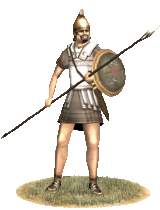 The Phalangitai Deuteroi are wealthier members of Makedonian or Eperiot society than the majority of peasants, but are still not in the class required to be considered Pezhetairoi (voting property owners), yet they can afford better equipment than their poorer taxeis hoplitai brethren. They are armored in good Phrygian helmets, quilted cloth armor that can dampen the effects of missiles, and are armed with the dreaded sarissa, a six meter long pike. They are disciplined enough to hold a line well, and as property owners, have a lot to lose if a battle does not go their way. They can be used as decent defensive infantry, well able to hold their own against most enemies, so long as that enemy is attacking from the front. They are still vulnerable to missiles and flanking attacks, though not as vulnerable as their less wealthy compatriots. They are more disciplined and better motivated than their Asian or Aigyptian counterparts in the armies of the Seleukidai or Ptolemaioi. The Phalangitai Deuteroi are wealthier members of Makedonian or Eperiot society than the majority of peasants, but are still not in the class required to be considered Pezhetairoi (voting property owners), yet they can afford better equipment than their poorer taxeis hoplitai brethren. They are armored in good Phrygian helmets, quilted cloth armor that can dampen the effects of missiles, and are armed with the dreaded sarissa, a six meter long pike. They are disciplined enough to hold a line well, and as property owners, have a lot to lose if a battle does not go their way. They can be used as decent defensive infantry, well able to hold their own against most enemies, so long as that enemy is attacking from the front. They are still vulnerable to missiles and flanking attacks, though not as vulnerable as their less wealthy compatriots. They are more disciplined and better motivated than their Asian or Aigyptian counterparts in the armies of the Seleukidai or Ptolemaioi.
Historically, the Phalangitai Deuteroi were only used during periods of extreme need or times when Makedon was invaded. They represent the lower end of the smallholder class, and as such, are the primary food providers of the social order. They were used only rarely, usually during invasions. They did give a good account of themselves against the Galatai and Thraikes invaders, but were found wanting as the armies of Philippos V and his son were cut down by Romaioi soldiers.
Akontistai (Hellenic Skirmishers)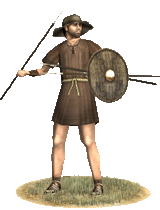 Those unlucky enough to be extremely poor freedmen were pressed into service as psiloi, missile units, and the lowest class of Hellene infantry. The psiloi were divided into three parts: javelineers, slingers, and archers. The javelin-armed psiloi, the akonistai, were ragged peasants armed with javelins and small knives. Their function was simply to throw their missiles and then run as fast as possible to safety behind the hoplitai lines. They were used for skirmishing and to provide a demoralizing hail of missile fire during the grinding battle between the two phalanxes. Never use akonistai in melee except as diversionary fodder or as a flanking force; roles in which they don't excel, but might actually be better than nothing. They have their uses, as their javelins are still sharp and deadly, but they were often used only as light skirmishers or as a last resort in Hellenic armies for obvious reasons. Those unlucky enough to be extremely poor freedmen were pressed into service as psiloi, missile units, and the lowest class of Hellene infantry. The psiloi were divided into three parts: javelineers, slingers, and archers. The javelin-armed psiloi, the akonistai, were ragged peasants armed with javelins and small knives. Their function was simply to throw their missiles and then run as fast as possible to safety behind the hoplitai lines. They were used for skirmishing and to provide a demoralizing hail of missile fire during the grinding battle between the two phalanxes. Never use akonistai in melee except as diversionary fodder or as a flanking force; roles in which they don't excel, but might actually be better than nothing. They have their uses, as their javelins are still sharp and deadly, but they were often used only as light skirmishers or as a last resort in Hellenic armies for obvious reasons.
Historically, akontistai did not play a particularly large role on the battlefield, and weren't normally a particularly decisive force. They were used mainly for their ability to induce an enemy to attack prematurely. They are little more than an annoyance on the open field, but can be deadly if positioned in places where their javelins can be used for maximum effect: on high terrain, on an enemy unit's flank, or atop a city wall.
Sphendonetai (Hellenic Slingers)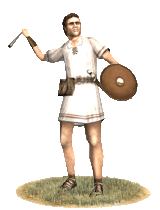 Sphendonetai are the second branch of the psiloi, and are only marginally more useful than their compatriots with javelins. Their sphendonai (slings) can prove deadly weapons, being able to crush bones and armor, and shatter shields from a distance, but they are mainly used to harass and annoy enemy soldiers to force a premature or rash action. Since a sphendone is an easily constructed weapon, and ammo is readily available in Hellas' rocky terrain, Sphendonetai are mostly poor peasants and shepherds that use this weapon to provide a meager amount of protein in their already poor diet or use their weapons to keep predators away from their flocks. Sphendonetai are the second branch of the psiloi, and are only marginally more useful than their compatriots with javelins. Their sphendonai (slings) can prove deadly weapons, being able to crush bones and armor, and shatter shields from a distance, but they are mainly used to harass and annoy enemy soldiers to force a premature or rash action. Since a sphendone is an easily constructed weapon, and ammo is readily available in Hellas' rocky terrain, Sphendonetai are mostly poor peasants and shepherds that use this weapon to provide a meager amount of protein in their already poor diet or use their weapons to keep predators away from their flocks.
Historically, sphendonetai had their uses, they were often used to harass and provoke the enemy forces by causing some casualties and some damage to the enemy's armament, particularly the shields, which were easily dented or cracked by a well slung glande (sling projectile). Alexandros employed his sphendonetai at the battle of Gaugamela to harass the Persian heavy cavalry until they decided to give fight, and then promptly cut them off from the rest of the Persian army, allowing the Hetairoi to cut them to shreds.
Toxotai (Hellenic Archers)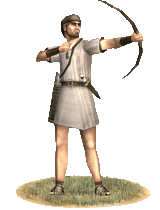 Toxotai are the third branch of the psiloi, the archers of Hellene and Makedonian armies. They are generally from the upper end of the poor and recruited from mountainous regions where the use of the bow is an essential skill to keep one's flock of sheep safe from roving predators. Toxotai are well trained in a manner of speaking, that being that they are using their weapon of choice (often of necessity) from birth. They are decent archers, but are nowhere near as professional as the archers from the east and south. They mostly use the short bow, which means that they are often outgunned by their counterparts from other lands. This reflects their secondary role in a Hellenic army. As most missile units, they will be cut to ribbons in melee, so they should be well protected from enemy ranks. Toxotai are the third branch of the psiloi, the archers of Hellene and Makedonian armies. They are generally from the upper end of the poor and recruited from mountainous regions where the use of the bow is an essential skill to keep one's flock of sheep safe from roving predators. Toxotai are well trained in a manner of speaking, that being that they are using their weapon of choice (often of necessity) from birth. They are decent archers, but are nowhere near as professional as the archers from the east and south. They mostly use the short bow, which means that they are often outgunned by their counterparts from other lands. This reflects their secondary role in a Hellenic army. As most missile units, they will be cut to ribbons in melee, so they should be well protected from enemy ranks.
Historically, the Hellenes did not use archers in any significant fashion. They did not have the composite bows of their neighbors, and their lands were not particularly suited to the cattle and horse farming that supplied the raw material for these bows. Therefore, archers fulfilled the same role as other psiloi: that of long range harassment. The Hellenes and Makedonians had no real tradition of archers and could not recruit any but these shepherds to do this work for them, since they lacked any access to the archers of the east. Most Hellene states relied on Skythian and most importantly Kretan archers to do this for them.
Hippakontistai (Hellenic Skirmisher Cavalry)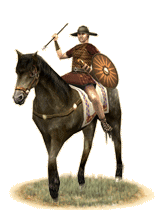 Hippos Akontistes (literally "javelin horsemen") are the standard among Hellene light cavalry. They are lightly armored, often wearing nothing but padded cloth for protection. The key to their method of warfare is speed, and they are armed accordingly. They ride small, but swift horses and harass enemy infantry and heavy cavalry with javelins. This is their primary use, because their light armor is really a detriment when they are engaged in any kind of melee combat. Their swords and shields are simply no counter to lances or heavier cavalry swords. Hippos Akontistes (literally "javelin horsemen") are the standard among Hellene light cavalry. They are lightly armored, often wearing nothing but padded cloth for protection. The key to their method of warfare is speed, and they are armed accordingly. They ride small, but swift horses and harass enemy infantry and heavy cavalry with javelins. This is their primary use, because their light armor is really a detriment when they are engaged in any kind of melee combat. Their swords and shields are simply no counter to lances or heavier cavalry swords.
Historically, Hellas did not have a great tradition of light cavalry warfare, or indeed of any cavalry warfare. Hippakontistai were much like the Equites of Rome, the spoiled children of the richest families that could afford horses. They were usually not used in any front line capacity other than skirmishing and pursuit, and their equipment reflects this. Makedonian cavalry of the same type operates in a similar fashion, but generally comes from the poorest noble families, those who can afford horses but not the heavy armor required for the heavy cavalry.
Hoplitai (Greek Classical Hoplites)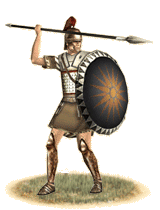 Even though the Makedonian phalangitai has become the dominant infantry type among the Hellenic powers, the hoplitai of old, those who fight in much the same manner as the Hellenes of Thermopylai, Marathon and Plataiai did, are still around defending their poleis. Each hoplites is equipped with linen or leather armor, an aspis shield, greaves, the attic style helmet and of course, his spear. Their equipment might have changed since the battles of a centuries past, but their tactics has not. The hoplitai still fight in the phalanx formation, often eight man deep whose purpose is to advance forward upon the enemy line, tie them and to whittle them down through attrition. Even though the Makedonian phalangitai has become the dominant infantry type among the Hellenic powers, the hoplitai of old, those who fight in much the same manner as the Hellenes of Thermopylai, Marathon and Plataiai did, are still around defending their poleis. Each hoplites is equipped with linen or leather armor, an aspis shield, greaves, the attic style helmet and of course, his spear. Their equipment might have changed since the battles of a centuries past, but their tactics has not. The hoplitai still fight in the phalanx formation, often eight man deep whose purpose is to advance forward upon the enemy line, tie them and to whittle them down through attrition.
Historically, the hoplites is one of the most famous types of soldiers that has ever existed. The Hellenic military ethos and culture from the 8th century and until the Roman hegemony created a highly skilled heavy infantryman. This combined with the phalanx formation, proved to be key factors in winning over the numerically larger Persian and barbarian armies of the day.
The hoplitai were mostly drawn from the well-to-do citizens of a polis, who often had a stake in the outcome of the battle or war to come, and who were bound to eachother by a patriotic feeling to their home city, creating a body of citizen-warriors whose motivation was unlike that of any levy, mercenary or other professional soldiers. The hoplites of the Hellenic city states continued to be the dominant infantry type on the battlefield for almost two centuries after the Persian Wars, but the appearance of the Peltastoi made them more vulnerable than before and highlighted the shortcomings of the phalanx, and the rise of Makedonia in the north and its phalangitai, became the decline of the "classical" hoplites being fielded in large numbers. However, variants of the hoplites were succesfully adapted by various Hellenic powers, like the Ekdromoi & Thorakitai Hoplitai. And even after the wars of Alexandros and those of his successors, some poleis and smaller communities still fielded contingents of hoplitai, who were trained and fought in the same fashion as the hoplitai of old.
Peltastai (Hellenic Heavy Skirmishers)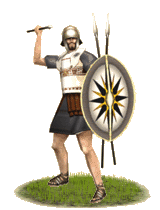 The Peltastai is a type of elite skirmisher that sacrifices heavy arms and armor for mobility and range. They are armored in linen and carry a medium sized ovular shield. Originally, they carried a crescent shaped 'pelta' shield, originated in Thrake and gave the peltastai their name, but this was phased out in the fourth century. Their armaments consist of several javelins and a sword. This panoply makes them light and mobile, but still able to engage in melee after their javelins have been thrown. They are a versatile unit but one must remember that their primary arms are javelins, and they are not equipped to stand toe to toe with heavier infantry. Their role is one of speed, harassment, and critical flanking maneuvers. The Peltastai is a type of elite skirmisher that sacrifices heavy arms and armor for mobility and range. They are armored in linen and carry a medium sized ovular shield. Originally, they carried a crescent shaped 'pelta' shield, originated in Thrake and gave the peltastai their name, but this was phased out in the fourth century. Their armaments consist of several javelins and a sword. This panoply makes them light and mobile, but still able to engage in melee after their javelins have been thrown. They are a versatile unit but one must remember that their primary arms are javelins, and they are not equipped to stand toe to toe with heavier infantry. Their role is one of speed, harassment, and critical flanking maneuvers.
Historically, the peltastai were often hoplitai or pezhetairoi equipped to fight in the manner of a skirmisher. This meant that they were adept melee combatants as well as being deadly with their javelins. Peltastai were used to great effect on ancient battlefields but by 270 BC the thureophoros was becoming the dominant melee skirmisher and the peltastai were carrying more javelins and were used in a manner that was consistent with this. This was simply a matter of specialization, and it did not mean that peltastai would be any less effective if deployed correctly. Their light armament makes them extremely fast, but tends to be to their detriment in melee combat. They were mostly used in the role of supporting missile troops who charged in at the last moment, after they had spent all their javelins. The great Athenian general Iphikrates is credited with the invention of the peltast as a distinct unit, and it is he that first employed them in this manner to great effect against the heavier armored and better trained hoplitai of Sparte.
Thureophoroi (Hellenic Spearmen)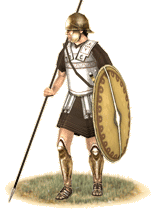 Thureophoroi were a new class of Hellenic infantry that was designed to both augment the phalanx and provide a type of soldier in between the phalangite and the peltastai that was able to both skirmish and fight in melee effectively. These men provide an extremely mobile force that can hit hard with their heavy javelins then rush in to flank pike units. They are well armed and armored for the task, having stout bronze helms, linen armor, an almond shaped thureos shield, heavy javelins, and a stout spear. They are highly versatile infantry, akin in spirit to the legionaries of Rome. They are a highly effective force of heavy infantry that is in the forefront of Hellenic military know-how. Thureophoroi were a new class of Hellenic infantry that was designed to both augment the phalanx and provide a type of soldier in between the phalangite and the peltastai that was able to both skirmish and fight in melee effectively. These men provide an extremely mobile force that can hit hard with their heavy javelins then rush in to flank pike units. They are well armed and armored for the task, having stout bronze helms, linen armor, an almond shaped thureos shield, heavy javelins, and a stout spear. They are highly versatile infantry, akin in spirit to the legionaries of Rome. They are a highly effective force of heavy infantry that is in the forefront of Hellenic military know-how.
Historically, Thureophoroi were used as harassing and flanking troops by the successor states. Though they were often described by Latin writers as copies of the legion, it is debatable whether they were developed with knowledge of warfare in Italy or not. Most Thureophoroi were Pezhetairoi, middle class property owners with voting rights, and as such, they were well able to devote time to training and practice and were highly disciplined and courageous troops. Despite their obvious advantages, or perhaps because of them, there was a lot of confusion as to how to utilize these new soldiers. As were deadly in the extreme to the less mobile phalanx units they forced a, much resisted, revaluation of Hellenic warfare. Perhaps for this reason the Diodachoi tended to used them conservatively, except for the Seleukidai, who took to these new soldiers quite well. The city-states of Hellas used them even more frequently against the armies of Makedonia, and were often able to hold the more powerful kingdom at bay. Still, their uses were limited in scope and not as widespread as their versatile and deadly role would have indicated. This is the fault of period commanders, however, and a more astute or innovative commander might have realized their potential in conjunction with the more static phalanx.
Prodromoi (Successor Medium Cavalry)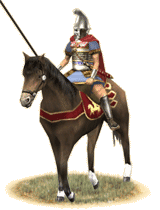 Prodromoi are the lightest of the Diadochoi melee cavalry and can be counted upon as superb flanking, raiding, and screening cavalry. They are well trained for light cavalry, but are still lightly armed and armored. They are not meant to be used as shock cavalry and will not roll up an enemy battle line in a thunderous charge, but instead make viable flanking cavalry which can quickly provide support where it is needed and be used to counter light missile troops of both the foot and mounted varieties. Their spears, shields, and linen armor give them some staying power, but they should not be used to in protracted melee for any great amount of time. Prodromoi are the lightest of the Diadochoi melee cavalry and can be counted upon as superb flanking, raiding, and screening cavalry. They are well trained for light cavalry, but are still lightly armed and armored. They are not meant to be used as shock cavalry and will not roll up an enemy battle line in a thunderous charge, but instead make viable flanking cavalry which can quickly provide support where it is needed and be used to counter light missile troops of both the foot and mounted varieties. Their spears, shields, and linen armor give them some staying power, but they should not be used to in protracted melee for any great amount of time.
Historically, the Seleukidai and Makedones used the smaller and weaker members of the nobility to form a quick and powerful light cavalry force that could decide an engagement on its own. Since these men are nobles, they have good staying power, as was evidenced by their widespread use in many battles. They are quick, and can be used to chase down missile cavalry when there is a need, due to the fact that they ride fast Thessalian horses and are relatively slight statured men. The Seleukidai use them as an effective counter to the Parthoi horse archers, much like the Hungarians of a later era did against the Turks.
Pezhetairoi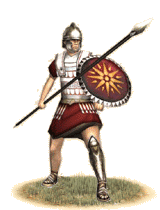 The Pezhetairoi are heart of the military machine of all the Diodachoi kindgoms. They are well disciplined and highly motivated pikemen that are armed and armored to the teeth. They are armored in a linen cuirass, a Thraikian cap, a bronze greave on the left leg, stout boots, good bracers, and reinforced shoulder pads made from hardened linen (due to their experience with the deadly curved swords of Thrace). They have Illyrian style round shields attached to their bodies by leather straps that help support the weight of the shield and keep their hand free to grasp the long and unwieldy sarissa. They are defensive infantry par excellence and are the anvil of the two part Makedonian system of warfare, the heavy cavalry being the hammer. They should be used to anchor enemy soldiers while the Theurophoroi harass the flanks and the heavy cavalry smashes into the flanks and rear. The Pezhetairoi are heart of the military machine of all the Diodachoi kindgoms. They are well disciplined and highly motivated pikemen that are armed and armored to the teeth. They are armored in a linen cuirass, a Thraikian cap, a bronze greave on the left leg, stout boots, good bracers, and reinforced shoulder pads made from hardened linen (due to their experience with the deadly curved swords of Thrace). They have Illyrian style round shields attached to their bodies by leather straps that help support the weight of the shield and keep their hand free to grasp the long and unwieldy sarissa. They are defensive infantry par excellence and are the anvil of the two part Makedonian system of warfare, the heavy cavalry being the hammer. They should be used to anchor enemy soldiers while the Theurophoroi harass the flanks and the heavy cavalry smashes into the flanks and rear.
Historically, the Pezhetairoi are the classic Alexandrian phalanx. They were used to great effect against the Persai, Medoi, Baktrioi, Indoi, Phoinikoi, and many, many others. They are an effective force and have not changed much over the centuries. The Romaioi were able to defeat them as easily as they did for two main reasons. One, the Romaioi army was at a high state of readiness and tactical prowess after defeating the Karchedoi. Two, the heavy cavalry arm of the Diodochoi armies had degenerated to the point where they were no longer able to field significant numbers to fulfill their part of the hammer and anvil tactic of Alexandros. There were also many lesser reasons, numbering among them the misuse of the Thureophoroi, the under use of Peltastai, and the lax state of warfare that the Diodachoi states were used to. In any case, the phalanx was not as anachronistic or inflexible as widely believed; it was simply misused and under-supported. In the thirteenth century and onwards, pikemen in similar formations were able to work wonders with more capable generals and a better cavalry arm. Do not under appreciate pikemen, for they are still a war winning force.
Argyraspides (Hellenic Elite Phalanx)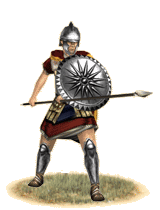 The veteran Pezhetairoi are often called Argyraspidai ("Silver Shields") in Makedonia, while in Arche Seleukeia they are drawn from the sons of mainly Makedonian military-settlers, primarily from the katoikiai, or military settlements, of Syria. These are tough men often better armed than their fellow phalanx soldiers, who usually are used to hold the center of a Makedonian or Seleukid battle line. They are older and more disciplined than other phalangitai and are thus able to hold their own against good odds. They are armed and armored much the same as regular Pezhetairoi, but with slightly better equipment and weapons, including scale reinforcement on their Linothorax. As with most elite units, they are best utilized as troops that take the brunt of an assault and can be counted upon to hold their ground. The veteran Pezhetairoi are often called Argyraspidai ("Silver Shields") in Makedonia, while in Arche Seleukeia they are drawn from the sons of mainly Makedonian military-settlers, primarily from the katoikiai, or military settlements, of Syria. These are tough men often better armed than their fellow phalanx soldiers, who usually are used to hold the center of a Makedonian or Seleukid battle line. They are older and more disciplined than other phalangitai and are thus able to hold their own against good odds. They are armed and armored much the same as regular Pezhetairoi, but with slightly better equipment and weapons, including scale reinforcement on their Linothorax. As with most elite units, they are best utilized as troops that take the brunt of an assault and can be counted upon to hold their ground.
Historically, the Silver Shields were an elite force within the armies of Alexandros, made up of the veterans often in their mid-40s and upwards. After the death of Alexandros, the term "Argyraspidai" came to describe the veterans among the Pezhetairoi, the soldiers aged 45-60. How this happened is anyone's guess, but it is what came to pass. In Makedonia the term was used to describe the veteran pezhetairoi who more often than not weren't a distinct corps, while in Arche Seleukeia they became the royal Guard, and carrying a silver shield was a mark of the elite. The Seleukid Argyraspidai seems to have been kept at a constant strength of around 10.000 men. How they were recruited is disputed, but one theory says they were sons of military settlers, who served in the royal Guard while their fathers tilled their land allotments, which were hereditary. This also had the added bonus of making every Argyraspides know who the true king was and where his loyalties were to be. The Makedonian Argyraspidai eventually "died out" and was replaced by the reformed Pezhetairoi, while the Seleukid Argyraspidai evolved into an assault infantry corps, the Thorakitai Argyraspidai, although one source suggests that the 10.000 man Silver Shields corps was divided into two halves, where 5000 men continued to fight as phalangitai and the other 5000 were armed in the new "Thorakitai" style.
Hysteroi Pezhetairoi (Macedonian Reformed Heavy Phalanx)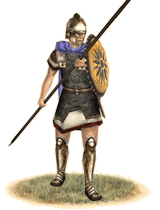 Early in the 2nd Century, after having fought the Romans in a few ruinous wars, the Macedonian army modified it's pike phalanx accordingly. Gone was the single greave and fully bronze shield, not to mention the linothorax. They were replaced with mail armor and a wooden composite (plywood) shield of similar strength but far less weight. They were retrained to a great degree, and many Thracians and Illyrians who settled in Macedon were added to the rolls. These men have a greater degree of training and equipment compared to their predecessors, and are better able to stand up to the mobile and disciplined troops of Rome or the Greeks to their south. Early in the 2nd Century, after having fought the Romans in a few ruinous wars, the Macedonian army modified it's pike phalanx accordingly. Gone was the single greave and fully bronze shield, not to mention the linothorax. They were replaced with mail armor and a wooden composite (plywood) shield of similar strength but far less weight. They were retrained to a great degree, and many Thracians and Illyrians who settled in Macedon were added to the rolls. These men have a greater degree of training and equipment compared to their predecessors, and are better able to stand up to the mobile and disciplined troops of Rome or the Greeks to their south.
Historically, the late pikemen were a development of the Macedonian Wars, in which Macedon was fighting a hopelessly outnumbered battle against the juggernaut of the Roman republic. They augmented their numbers by adding non-Macedonians to the rolls and trained those that they had far better, using new methods. The result was better than the earlier pikemen, but still not enough to defeat the Roman armies at the state of readiness they were at after the second Punic War. If Rome could defeat Carthage, which once had a massive amount of capital and excellent manpower to draw upon, then she could certainly defeat little Macedon, whose population had been depleted to a large extent due to eastern migration of many citizens.
Hippeis Thessalikoi (Thessalian Heavy Cavalry)
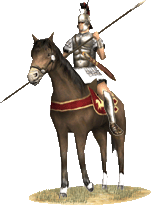 Thessalikoi heavy cavalry are drawn from the nobility of Thessalia, a region thoroughly under Makedonian control. They are extremely valuable heavy cavalry, well able to crush enemy resistance with a single thunderous charge. While not quite as powerful as the Hetairoi of Makedonia itself, the Thessalikoi are well able to give a good account of themselves in battle. Their lances and blades, combined with their shields, make them well able to hold in a melee after the charge has been completed and they have a degree of discipline that is enviable among cavalry warriors. Thessalikoi heavy cavalry are drawn from the nobility of Thessalia, a region thoroughly under Makedonian control. They are extremely valuable heavy cavalry, well able to crush enemy resistance with a single thunderous charge. While not quite as powerful as the Hetairoi of Makedonia itself, the Thessalikoi are well able to give a good account of themselves in battle. Their lances and blades, combined with their shields, make them well able to hold in a melee after the charge has been completed and they have a degree of discipline that is enviable among cavalry warriors.
Historically, Thessalia was famous for its heavy cavalry. Unlike southern Hellene regions, the Thessalikoi had a wide expanse of plains and were able to breed horses extensively. They were able to keep the other Hellenes at bay even though they were poorer and less populous than their southern neighbors. They were joined with Makedonia during the reign of Phillipos, and provided cavalry to fuel Alexandros’ conquests. After Alexandros, they continued to provide heavy cavalry to the Makedonians until the Rhomaios invasion of 146 BC that destroyed much of Thessalia’s infrastructure. There is evidence that by this time heavy cavalry was employed only in smaller numbers, due to cost.
Lonchophoroi Hippeis (Hellenic Medium Cavalry)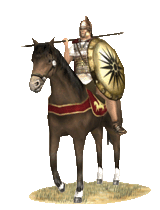 Hail Stratege! Fine noblemen forming a sturdy body of cavalry whose purpose is to crash into your foe and have the staying power to breach his line are here, arrayed before you. Armed with stout single handed lances and the mighty aspis of our ancestors, they can unleash a terrible charge. Once they have inflicted gruesome casualties on our enemies, they will switch to their melee weapon and begin a close-in slaughter. While men from Epeiros or Makedonia proper would have the sturdy Kopis, men further east may prefer the stout bladed war axe like that used by Alexander at the Granicus. They are armored with scale reinforced linen, greaves, and masked Phrygrian helmets that betray naught but the angry face of Zeus Pater or wrathful Poseidon. They are best used as a general purpose heavy cavalry. However, if facing the sturdier men from the east, or, Gods forbid, the elite Hetairoi or massive Kataphraktoi of the Seleukides and Baktrioi, they may not have the staying power that they would against other heavy cavalry. Use them well, and they will give your enemies naught but the death they so richly deserve! Hail Stratege! Fine noblemen forming a sturdy body of cavalry whose purpose is to crash into your foe and have the staying power to breach his line are here, arrayed before you. Armed with stout single handed lances and the mighty aspis of our ancestors, they can unleash a terrible charge. Once they have inflicted gruesome casualties on our enemies, they will switch to their melee weapon and begin a close-in slaughter. While men from Epeiros or Makedonia proper would have the sturdy Kopis, men further east may prefer the stout bladed war axe like that used by Alexander at the Granicus. They are armored with scale reinforced linen, greaves, and masked Phrygrian helmets that betray naught but the angry face of Zeus Pater or wrathful Poseidon. They are best used as a general purpose heavy cavalry. However, if facing the sturdier men from the east, or, Gods forbid, the elite Hetairoi or massive Kataphraktoi of the Seleukides and Baktrioi, they may not have the staying power that they would against other heavy cavalry. Use them well, and they will give your enemies naught but the death they so richly deserve!
Historically, the lancers of later Hellenistic armies were divided into several types. Some cavalry performed shock roles as a secondary function, with the charge itself being their goal, and thus it became necessary to develop a specific force of cavalry who could charge in suppport but lend staying power to their comrades. This sort of cavalry was used to great effect by the forces of Syrakousai and Taras in the west, Epeiros, Pergamon and Makedonia in the heartland of the Greek and Makedonian peoples, and the even the great Hellenistic kingdoms of Aigyptos, Syria, and Baktria. They appear on both sides at the battle of Magnesia, where they and the Pergamene Hetairoi checked the advance of more heavily armored Seleukid cavalry, allowing the Romans to roll up the line of Seleukid infantry. Still, they have some weaknesses, and should not be expected to defeat elite troops in prolonged battle.
Hetairoi Aspidophoroi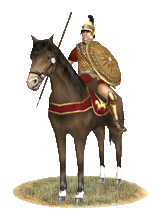 Hail Stratege! The men mounted before you are among your most vital cavalrymen. Armored in leather torso armour and carrying stout shields, they are well able to last in melee. After throwing their iron tipped javelins, they will retreat behind the shock cavalry, and then help to exploit the breakthrough made by the lancers by weight and skill. Do not misuse them, for they are an elite among your horsemen, and are difficult to replace. Still, they are well able to hold their own in virtually any melee, since each man's heavy kopis will deal death to those infantry who dare approach them. Hail Stratege! The men mounted before you are among your most vital cavalrymen. Armored in leather torso armour and carrying stout shields, they are well able to last in melee. After throwing their iron tipped javelins, they will retreat behind the shock cavalry, and then help to exploit the breakthrough made by the lancers by weight and skill. Do not misuse them, for they are an elite among your horsemen, and are difficult to replace. Still, they are well able to hold their own in virtually any melee, since each man's heavy kopis will deal death to those infantry who dare approach them.
Historically, the successor states fielded cavalry different from what Alexandros had used. These men solved a very practical problem: how do you soften up an infantry line for a charge, and then exploit it afterward? After the early days of the successor kingdoms, there were never enough men of this stature to make a massive impact on the battlefield. But, perhaps you will learn from the mistake of allowing your own opulence overshadow the needs of your army?
Hypaspistai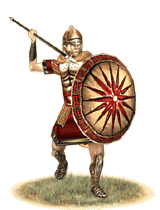 Hail, Basileu! Before you stand your Hypaspistai: the elite of the elite and your personal guard. They are armed and armored in the finest equipment of the traditional hoplite: aspis, greaves, cuirass, helmet, spear, and sword. They are the best and richest of your men; far too worthy to risk in unwise actions. And yet they are without a doubt capable of multiplying the power of your army. Forming the right wing of the battle line or leading the assault on fortifications their heavy armor and weapons allow them to stand against even the hardiest of opponents and triumph with ease. They should be deployed where the fighting will be at its absolute thickest or nearby to fight with and to protect you. Hail, Basileu! Before you stand your Hypaspistai: the elite of the elite and your personal guard. They are armed and armored in the finest equipment of the traditional hoplite: aspis, greaves, cuirass, helmet, spear, and sword. They are the best and richest of your men; far too worthy to risk in unwise actions. And yet they are without a doubt capable of multiplying the power of your army. Forming the right wing of the battle line or leading the assault on fortifications their heavy armor and weapons allow them to stand against even the hardiest of opponents and triumph with ease. They should be deployed where the fighting will be at its absolute thickest or nearby to fight with and to protect you.
Historically, the Hypaspistai (shield-bearers) first appear with Alexandros at the beginning of his reign as his elite troops and bodyguard. He used them extensively throughout his anabasis for special missions, assault of fortifications, and in support of light troops in rough terrain; however, details of the unit seem to disappear by the time Alexandros reaches India and remain as such until appearing in various sources for the three remaining Diadochoi kingdoms in different forms and perhaps briefly in Epeiros with Pyrrhos. Such examples of their deployment count them as possibly numbering a fifth of the 10,000 Arygraspides corps of the Seleukid kings or as the military police and closest guard of the Makedonian kings. Yet, despite their prowess, the Hypaspistai were either forced to evolve past the antiquated hoplite model as in the east or vanish with the fall of their kingdom as in the west.
Peltastai Makedonikoi (Hellenistic Elite Infantry)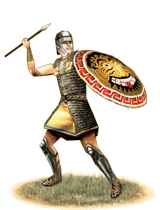 Hail, Basileu! These men are the Peltastai and among the elite of your army. Men in their prime and drawn from the upper echelons of society they have been fitted with fine armor, a sword, and javelins. They excel in assault where their javelins can scatter defenders from breaches in defenses made by your siege engines. In the open field, their equipment, lighter in comparison to the heavily armed Hypaspistai, makes them adept at flanking the enemy battle line or exploiting openings made by your other troops. Hail, Basileu! These men are the Peltastai and among the elite of your army. Men in their prime and drawn from the upper echelons of society they have been fitted with fine armor, a sword, and javelins. They excel in assault where their javelins can scatter defenders from breaches in defenses made by your siege engines. In the open field, their equipment, lighter in comparison to the heavily armed Hypaspistai, makes them adept at flanking the enemy battle line or exploiting openings made by your other troops.
Historically the elite Peltastai Makedonikoi appear at some point during the late 3rd century as the guard of the Antigonid kings and later with the other Diadochoi. The precise moment is not known due to scarcity of information concerning period between the Battle of Ipsos and start of second Punic War. It is from both Polybios and inscriptions found in Makedonia that we learn of them; that they were among the most fit Makedones available to the king; and likely the sons of noble families. They were younger than 35 and so at the peak physical strength for the average man. Their role in war was similar to that of Hypaspistai in the army of Alexander the Great: assault of fortifications, supporting light troops in broken terrain, and performing special missions that required both skill and strength. In set battles they could be equipped with sarissai and fight with the phalanx positioned in the place of honor at the right wing close to the king. Commanders of the Peltastai were among the most important persons in kingdom, as evidenced by Antigonos Doson's naming the contemporary commander of the unit, along with four others, as protector of a young Phillipos V.
.
Hetairoi (Companion Cavalry)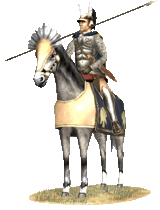 The Hetairoi, or Companions, were the elite noble heavy cavalry of Makedon and the Diadochoi. They are an elite heavy cavalry that is second to none and arguably the best cavalry of the period. They fight with a degree of élan, discipline, and simple ferociousness that is matched only by the horsemen of Iberia, Karchedon, and the best heavy cavalry of the eastern nomadic peoples. They are armored from head to toe in iron plate (some still had bronze, but this was falling out of favor rapidly by 250 BC), reinforced with mail at key points. Their horses are barded with felt barding and often have bronze plates to protect their heads. Their helmets, with the two plumes, mark them on a battlefield. They are best used as heavy shock cavalry, able to decide many battles with a single charge. They are the second part of the hammer and anvil of Alexandrian battle tactics. They are armed with a xyston and a kopis, and are true masters of both weapons. If these men have any weakness, it is the front of a line of spearmen. Horses, not matter how well trained, simply do not want to charge into certain death. Nevertheless, these superb cavalry men are easily able to devastate even the toughest of foes with a well timed charge into their flanks or rear. The Hetairoi, or Companions, were the elite noble heavy cavalry of Makedon and the Diadochoi. They are an elite heavy cavalry that is second to none and arguably the best cavalry of the period. They fight with a degree of élan, discipline, and simple ferociousness that is matched only by the horsemen of Iberia, Karchedon, and the best heavy cavalry of the eastern nomadic peoples. They are armored from head to toe in iron plate (some still had bronze, but this was falling out of favor rapidly by 250 BC), reinforced with mail at key points. Their horses are barded with felt barding and often have bronze plates to protect their heads. Their helmets, with the two plumes, mark them on a battlefield. They are best used as heavy shock cavalry, able to decide many battles with a single charge. They are the second part of the hammer and anvil of Alexandrian battle tactics. They are armed with a xyston and a kopis, and are true masters of both weapons. If these men have any weakness, it is the front of a line of spearmen. Horses, not matter how well trained, simply do not want to charge into certain death. Nevertheless, these superb cavalry men are easily able to devastate even the toughest of foes with a well timed charge into their flanks or rear.
Historically, the Hetairoi were first created by Philippos, following the lead of the cavalrymen of Thessalia, to the south. Philippos went one better, armoring them to the teeth and giving them the xyston, a twelve foot long lance tipped with a large steel head. They were armored head to toe in bronze plate, with helms, cuirass, bracers and greaves. Alexandros often replaced this armor with lighter linen when they were traveling, but was quick to replace the bronze in any hard fought engagement. Alexandros added little to their equipment but trained them to ride their horses in such a way that each man was an expert horsemen as well as a shock cavalryman. The Diadochoi kept this mold, but added mail reinforcement to the bronze armor at the joints before replacing it with iron and added felt and lamellar barding to the horses after encountering enemy cavalry that used such equipment with a high degree of success. During the third century their usage declined with the Diadochoi's ability to pay for such heavily armored men. They degenerated to such a point where only a handful were present at major battles, and were far from the war winning force that they had been earlier. Perhaps with a bit of luck and more funding, a commander could use them in their true glory once more…
Agrianikoi Pelekephoroi (Agrianian Assault Infantry)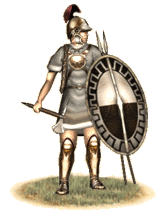 The Agrianians are an Illyrian tribe that has many Thracian influences. Most now live in northern Macedonia, where they are actively recruited. The Agrianians are famed for their acrobatics and climbing ability, and are well known as an exceedingly fierce tribe. They've been recruited by the Macedonians in large numbers for many years, and are now indebted to the Macedonian king for protecting them against the huge invasion of the Galatians. They wear little in the way of armor, wearing only a small round bronze breastplate that doubles as a bowl and leather greaves that protect their legs from the jagged rocks. They carry daggers and axes, both modified to use as climbing tools. Their daggers are particularly long and specially shaped to make them both climbing spikes and excellent melee weapons. They actually have a fairly advanced martial art based around these weapons. They carry thureoi and wear attic helmets, and round out their equipment with javelins. Agrianians are famous javelineers, able to throw their javelins farther and with more force than many others. They are best used as assault infantry, their javelins, speed, and axes can work wonders on heavier troops. They are fanatic soldiers who often lose themselves into a battle frenzy, able to tackle enemies with far more armor. They are among the best and fastest infantry available to the Macedonian Kingdom. The Agrianians are an Illyrian tribe that has many Thracian influences. Most now live in northern Macedonia, where they are actively recruited. The Agrianians are famed for their acrobatics and climbing ability, and are well known as an exceedingly fierce tribe. They've been recruited by the Macedonians in large numbers for many years, and are now indebted to the Macedonian king for protecting them against the huge invasion of the Galatians. They wear little in the way of armor, wearing only a small round bronze breastplate that doubles as a bowl and leather greaves that protect their legs from the jagged rocks. They carry daggers and axes, both modified to use as climbing tools. Their daggers are particularly long and specially shaped to make them both climbing spikes and excellent melee weapons. They actually have a fairly advanced martial art based around these weapons. They carry thureoi and wear attic helmets, and round out their equipment with javelins. Agrianians are famous javelineers, able to throw their javelins farther and with more force than many others. They are best used as assault infantry, their javelins, speed, and axes can work wonders on heavier troops. They are fanatic soldiers who often lose themselves into a battle frenzy, able to tackle enemies with far more armor. They are among the best and fastest infantry available to the Macedonian Kingdom.
Historically, the Agrianians were used by Alexander in almost every major battle of his conquest, often to a great effect. They were fanatically loyal and were called upon as his best assault troops, able to throw their ropes and grappling hooks and use their spiked boots and specialized equipment to scale even sheer surfaces. They fought fanatically and continued this tradition under Macedonian leadership.
Thraikioi Doryphoroi (Thracian Light Spearmen)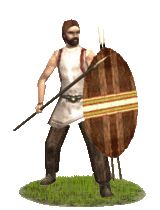 Among the Thraikian tribes, the vast majority of men of military age are too poor to fight in the bands of well-equipped units. As farmers, herders, and general pastoralists, many of these Thraikians cannot afford more than a few pieces of military equipment. For that reason many of them carry simple wooden shields, a clutch of javelins with fire-hardened wooden tips, and a simple spear. While many of the warriors who perform service for their tribe are these farmers, herders, and fishermen, many of them are also accustomed to a form of warfare through their incessant, low intensity squabbles with neighboring tribes, or even through occasional raids on passing trading parties or local trading emporia. So while they lack good weaponry, or armor, they carry a ferocious disposition - they are Thraikians, after all. While they may carry their ferocity on to the battlefield, their lack of experience in much of anything larger than a skirmish over farmland may cause their ferocity to dissipate in the face of prolonged hand-to-hand combat with well-ordered, or even professional, soldiery. They are accustomed to short skirmishes and decisive charges, and so are best used in similar roles. Among the Thraikian tribes, the vast majority of men of military age are too poor to fight in the bands of well-equipped units. As farmers, herders, and general pastoralists, many of these Thraikians cannot afford more than a few pieces of military equipment. For that reason many of them carry simple wooden shields, a clutch of javelins with fire-hardened wooden tips, and a simple spear. While many of the warriors who perform service for their tribe are these farmers, herders, and fishermen, many of them are also accustomed to a form of warfare through their incessant, low intensity squabbles with neighboring tribes, or even through occasional raids on passing trading parties or local trading emporia. So while they lack good weaponry, or armor, they carry a ferocious disposition - they are Thraikians, after all. While they may carry their ferocity on to the battlefield, their lack of experience in much of anything larger than a skirmish over farmland may cause their ferocity to dissipate in the face of prolonged hand-to-hand combat with well-ordered, or even professional, soldiery. They are accustomed to short skirmishes and decisive charges, and so are best used in similar roles.
Thrakioi Hippeis (Thracian Light Cavalry)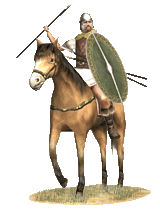 Thraikoi Hippeis are skilled Thracian skirmisher cavalry who harass their enemies with javelins. To maintain high mobility they wear no armor beneath their characteristic cloaks (called "zeira"), but their small thureos shields and Phrygian helmets with cheek guards provide some protection from their foes. They are trained in the use of the wedge formation and their Scordisci swords can be effective in close quarter fighting, but they are best used harassing infantry or slower cavalry at range. Thraikoi Hippeis are skilled Thracian skirmisher cavalry who harass their enemies with javelins. To maintain high mobility they wear no armor beneath their characteristic cloaks (called "zeira"), but their small thureos shields and Phrygian helmets with cheek guards provide some protection from their foes. They are trained in the use of the wedge formation and their Scordisci swords can be effective in close quarter fighting, but they are best used harassing infantry or slower cavalry at range.
Historically, these hard-fighting troopers were known for their fearlessness and swift maneuverability. They adopted hit-and-run cavalry tactics after their many encounters with the Skythians, making the Thraikoi Hippeis the bane of heavier and slower enemies. Megas Aleksandros employed Thracian skirmisher cavalry in his journeys, and their reputation was that of hard-drinking, uninhibited people. In battle they preferred to throw the first volley of cornel-wood javelins at maximum range so they could quickly ready a follow-up volley.
Taxeis Triballoi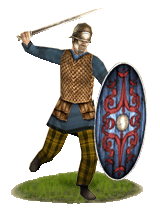 The Triballoi are a particularly fierce Thraikian tribe that contributes a very deadly assault infantry to any Thraikian warlord or any strategos who hires them. These Thraikians are wearing leather armor with ptyreges, leather greaves, Thracian helms and thureos shields and they are armed with javelins and Skythian longswords. True to their Thraikian ancestry they are ferocious warriors who fight with an intensity unmatched by other troops in the region. They are more than capable of going toe to toe with most other medium infantry and can be utterly lethal as flankers against heavier infantry. Their javelins give them another edge, as they can unleash a volley or two before closing in on the hopefully thinned enemy formation. In short, they are a very able assault infantry if properly used on the battlefield. The Triballoi are a particularly fierce Thraikian tribe that contributes a very deadly assault infantry to any Thraikian warlord or any strategos who hires them. These Thraikians are wearing leather armor with ptyreges, leather greaves, Thracian helms and thureos shields and they are armed with javelins and Skythian longswords. True to their Thraikian ancestry they are ferocious warriors who fight with an intensity unmatched by other troops in the region. They are more than capable of going toe to toe with most other medium infantry and can be utterly lethal as flankers against heavier infantry. Their javelins give them another edge, as they can unleash a volley or two before closing in on the hopefully thinned enemy formation. In short, they are a very able assault infantry if properly used on the battlefield.
Historically, the Triballoi were among the most fierce and warlike of the Thracian tribes, although that has been said about most Thracian tribes. However, it might have more merit for the Triballoi, as they were a byword for savagery and an Athenian club for lawless youths was named after them. The Triballoi were once subdued by Philippos II, and then again by Alexandros. Alexandros was so impressed by them that he hired many and brought them on his Persian expedition. They were instrumental as assault infantry, and were able to outfight the Persian infantry on every occasion that they met them. These troops had a simple philosophy of war. Throw javelins, charge, and then rip your enemies apart. For such simple tactics, they were wildly effective against most enemies.
The Triballoi were in constant contact with the Getai and Skythians and also the Illyrians. One Illyrian tribe, the Autariatai, overcame the Triballi around 424 and forced them out of their original homelands further south than their present location and they were also hard pressed centuries later when the Celts migrated to the area. The Skythian, Illyrian and later Celtic influences on the Triballoi might be the reason they are sometimes mentioned as distinct from the other Thracian tribes.
Thrakioi Peltastai (Thracian Peltasts)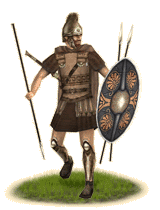 The Thracian Peltast was the originator and the best of the peltasts and these men will often give a better service than their Hellenic counterparts. They are armored in good quality linen and carry a smaller version of the thureos style shield. They are Hellenized warriors, but still have their trademark wild beards, which serve to remind their enemies of their country of origin. They are expert javelinmen, able to pepper their targets with javelins before charging in with their fearsome rhomphaias. They are well trained and among the fiercest and most feared warriors in the entire world, and they know it. This often makes them very impetuous, but an able general should be able to keep them at bay until the right moment. Thrakioi Peltastai can be used with equal precision as skirmishers or medium shock infantry. They are even deadly against armored horsemen, due to their wicked armor-piercing blades. The Thracian Peltast was the originator and the best of the peltasts and these men will often give a better service than their Hellenic counterparts. They are armored in good quality linen and carry a smaller version of the thureos style shield. They are Hellenized warriors, but still have their trademark wild beards, which serve to remind their enemies of their country of origin. They are expert javelinmen, able to pepper their targets with javelins before charging in with their fearsome rhomphaias. They are well trained and among the fiercest and most feared warriors in the entire world, and they know it. This often makes them very impetuous, but an able general should be able to keep them at bay until the right moment. Thrakioi Peltastai can be used with equal precision as skirmishers or medium shock infantry. They are even deadly against armored horsemen, due to their wicked armor-piercing blades.
Historically, the Thraikioi Peltastai have been around since the late Bronze Age and are often considered the archetype of the Thracian warrior, though these Hellenized Peltastai are considerably more heavily armored than their fifth century ancestors. The Thrakioi Peltastai have been plying their deadly trade against Hellenes for as long as any Thrakian or Hellene can remember, and their method of warfare was so effective it was copied by the Hellenes and Makedonians and even mimicked by tribes as distant as the Illyrians. The number of battles and by whom they were used is uncountable. Suffice to say Thrakian peltastai have been used in every major conflict between Hellenic states, and will continue to be used.
Thraikioi Rhomphaiaphoroi (Elite Thracian Infantry)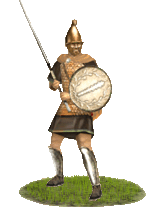 The elite infantry of the Thraikian tribes are armed with the heaviest of Thraikian weapons, the rhomphaia. Unlike most other Thraikian warriors, these warriors can afford relatively heavy armor and are thus armored with chain mail or scale cuirasses, Phrygian helmets--often with elaborately moulded cheek pieces, bronze greaves and a pelta. They are armored infantry killers of great renown, well able to chop their way through heavily armored enemy soldiers. These soldiers can even be effective against armored horsemen, since their large rhomphaia have been known to sheer through the legs of horses. In the right hands, this band of warriors can be a devastating battle-winning force in itself. The elite infantry of the Thraikian tribes are armed with the heaviest of Thraikian weapons, the rhomphaia. Unlike most other Thraikian warriors, these warriors can afford relatively heavy armor and are thus armored with chain mail or scale cuirasses, Phrygian helmets--often with elaborately moulded cheek pieces, bronze greaves and a pelta. They are armored infantry killers of great renown, well able to chop their way through heavily armored enemy soldiers. These soldiers can even be effective against armored horsemen, since their large rhomphaia have been known to sheer through the legs of horses. In the right hands, this band of warriors can be a devastating battle-winning force in itself.
Historically, there were relatively few of these soldiers in any Thraikian army, but they were always at the forefront, where the fighting was thickest. Each had risen to a position of power within his respective tribe, often they formed the elite troops of the chief or local king. The Rhomphaiaphoroi represent the pinnacle of the Thracian military know-how. In the old Thraikian way of battle, the Rhomphaiaphoroi would form the brunt of a decisive charge, once the Peltastai had worn down the enemy. Their charge was nearly unstoppable, and often led to outright routs against less stalwart opponents, as their fearful Rhomphaia, sturdy weapons composed of nearly two meters of heavy iron, could pierce thick armor, and cleave limb from torso with little trouble. With their row of long iron points, bands of Rhomphaiaphoroi could also defend against oncoming horse, and when wielded by a skilled swordsman a single blow could hamstring a horse or sever an enemy’s limbs.
Thrakioi Prodromoi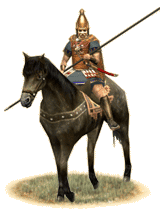 In the Thraikian and Makedonian armies, these medium cavalry are a common sight. The reason for this is that they are excellent medium cavalry, capable of skirmishing, charging, and fighting fairly well in melee. They are armored with good quality linen, bronze helms, and the distinctive Thraikian shields that mark their country of origin. They are an extremely versatile cavalry force that can be given the moniker ‘jack of all trades and master of none’. They are great all-round cavalry, but will not fare well against heavier cavalry or spear or pike armed infantry. They are drawn from the lower Thraikian nobility and many have settled in Makedonia, lured by land grants and higher pay. In the Thraikian and Makedonian armies, these medium cavalry are a common sight. The reason for this is that they are excellent medium cavalry, capable of skirmishing, charging, and fighting fairly well in melee. They are armored with good quality linen, bronze helms, and the distinctive Thraikian shields that mark their country of origin. They are an extremely versatile cavalry force that can be given the moniker ‘jack of all trades and master of none’. They are great all-round cavalry, but will not fare well against heavier cavalry or spear or pike armed infantry. They are drawn from the lower Thraikian nobility and many have settled in Makedonia, lured by land grants and higher pay.
Historically, Thraikian light cavalry was some of the best in the ancient world. They proved their worth in battle after battle, whether in Makedonian or Hellene service, or the service of their own kings. Their tactical versatility made them a light cavalry equivalent to the Romaioi legions, well able to perform any battle role and to adapt quickly to any circumstance.
|
 |
|
 |






















|